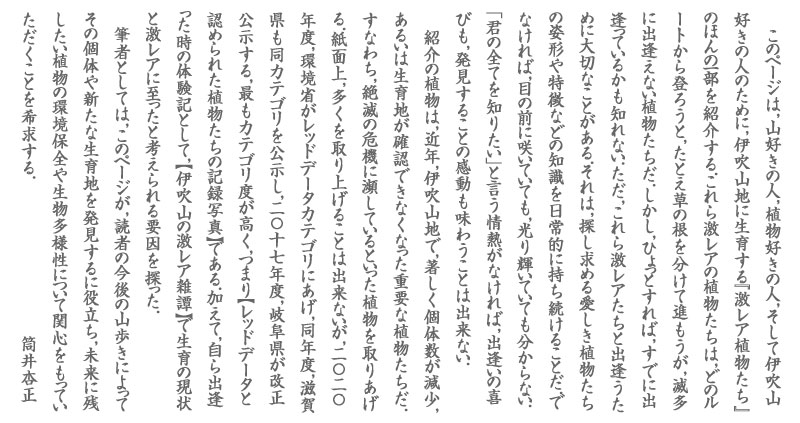This page introduces just a few of the extremely rare plants that grow in the Ibuki Mountains, for people who love mountains, plants, and Mt. Ibuki.These extremely rare plants are rare to come across, no matter which route you take to climb the mountain, even if you separate the grass roots.But maybe you've already met them.However, there is something important in order to meet these super rares.The key is to maintain knowledge about the shapes and characteristics of the beloved plants you are looking for on a daily basis.Otherwise, even if it blooms right in front of you, you won't be able to tell even if it shines brightly.If you don't have the passion to know everything about plants, you won't be able to experience the joy of encounters and the excitement of discoveries.If you don't have the passion to know everything about you, you won't be able to experience the joy of meeting someone or the excitement of discovery.
The plants introduced here are important plants of the Ibuki Mountains, whose populations have decreased significantly in recent years or whose habitats can no longer be confirmed.In other words, we will focus on plants that are on the verge of extinction.
Although it is not possible to cover much on paper, in 2020, the Ministry of the Environment placed it in the red data category, and in the same year, Shiga Prefecture also announced the same category, and in 2017, Gifu Prefecture revised and announced the highest category. In other words, it is a [documentary photo of plants recognized as red data].I also wrote about my own experience when I encountered it in [Ibukiyama Super Rare Chats], and explored the current state of its growth and the factors that are thought to have made it extremely rare.
The author hopes that this page will help readers discover individual species and new habitats during their future mountain walks, and that they will become interested in the environmental conservation and biodiversity of plants that they want to preserve for the future. |




































































































